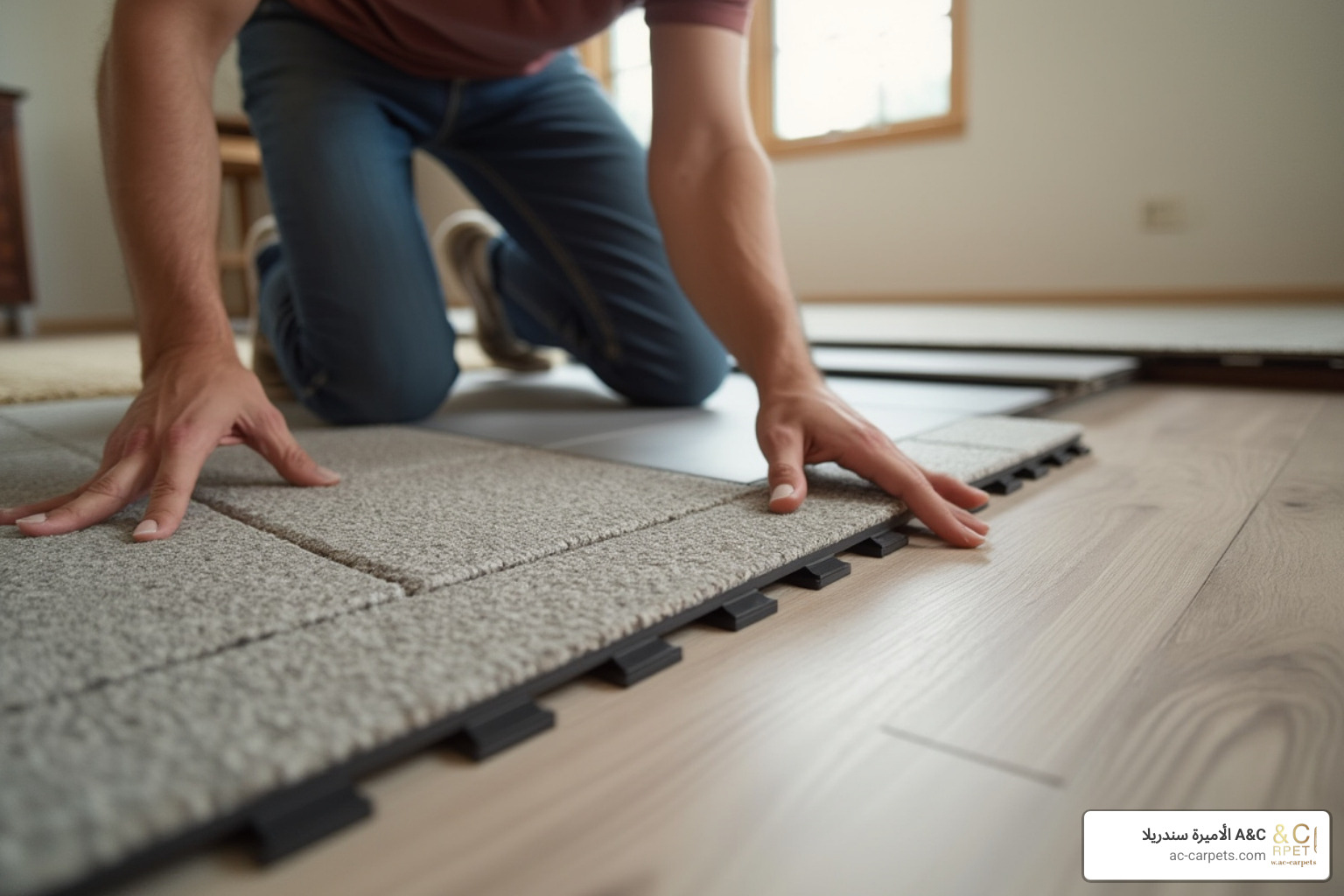Cheapest Way to Replace Carpet: Top 3 Smart Hacks
Why Budget-Friendly Flooring Doesn’t Mean Cheap Quality
Looking for the cheapest way to replace carpet without sacrificing style or durability? You’re not alone. The national average price for new carpet ranges from $783 to $2,810, but smart alternatives can cost significantly less while delivering better performance.
Quick Answer – Top 5 Cheapest Ways to Replace Carpet:
- Vinyl tiles – $1-$4 per sq ft (waterproof, DIY-friendly)
- Sheet vinyl – $1-$2 per sq ft (seamless, easy maintenance)
- Ceramic tile – $0.50-$7 per sq ft (ultra-durable)
- Peel-and-stick carpet tiles – $1.50-$3.50 per sq ft (instant install)
- Painted subfloor – Under $1 per sq ft (creative, temporary solution)
Old carpet brings more than just aesthetic problems. It traps allergens, absorbs odors, and shows every stain. Meanwhile, modern alternatives like luxury vinyl planks and ceramic tiles offer superior durability, easier cleaning, and often cost less than quality carpeting.
The secret isn’t just picking cheap materials – it’s understanding which options deliver the best value for your specific needs. Some vinyl flooring can last up to 25 years with proper care, while cheap carpet typically lasts only 1-5 years.
As Ramy Saber, founder of الأميرة سندريلا A&C, I’ve helped countless clients find the cheapest way to replace carpet while achieving modern, neat results through innovative flooring alternatives. My engineering background and experience in facility management have shown me that the right flooring choice combines affordability with long-term performance.
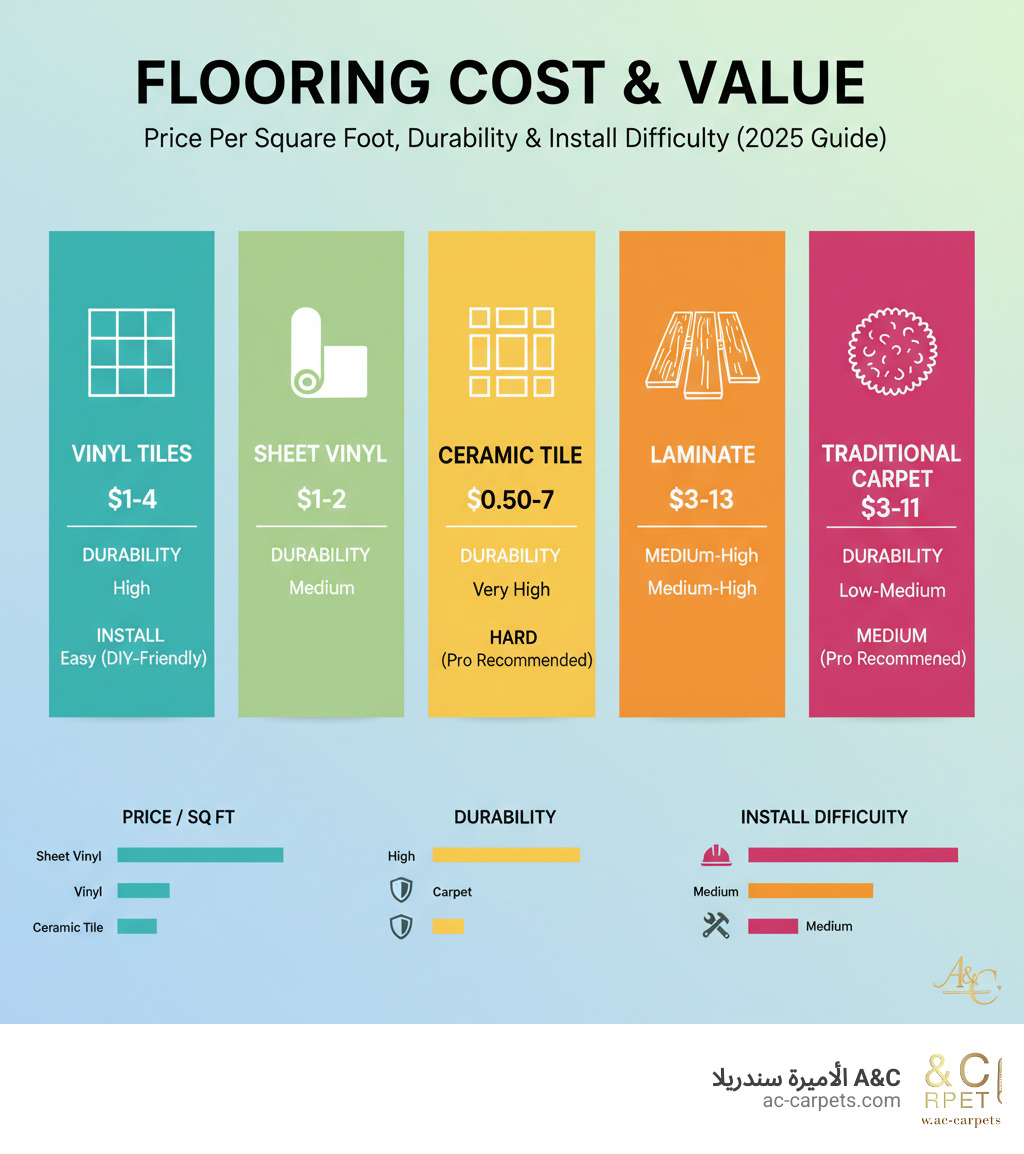
Before You Begin: What’s Hiding Under Your Carpet?
To find the cheapest way to replace carpet, you must know what you’re working with underneath. What’s hiding beneath that old carpet could be your biggest money-saver or your biggest headache.
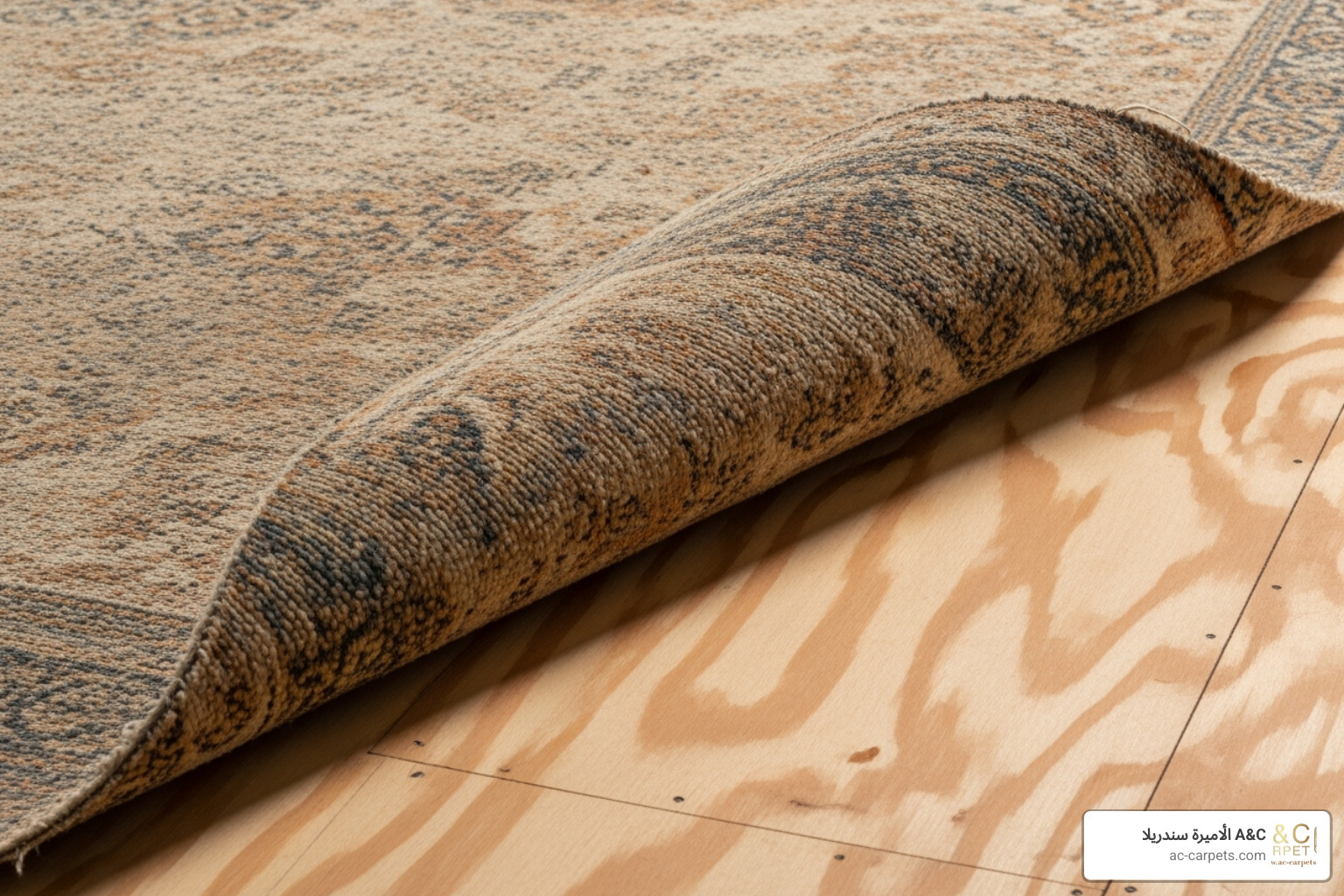
The Great Reveal: Subfloor Inspection
Picture this: you’re finally ready to rip up that stained, smelly carpet that’s been bothering you for months. But before you start dreaming about your beautiful new floors, you need to play detective. What lies beneath could completely change your game plan.
DIY carpet removal is usually your first money-saving move, and honestly, it’s not as scary as it sounds. It’s messy and a bit tedious, but it’s totally doable for most homeowners. The key is going in prepared and taking your time.
Safety gear is essential. Use sturdy gloves to protect your hands from tack strips and staples. A dust mask is crucial because old carpet padding can release particles you don’t want to breathe.
Start by cutting the carpet into manageable strips with a sharp utility knife. Keep those cuts shallow – you’re not trying to carve through to the basement! Roll up each strip and tape it shut for easier hauling. Next, remove the tack strips from the room’s perimeter and pull out the many staples from the old padding. A pry bar, hammer, and needle-nose pliers will be essential.
Now for the moment of truth – what’s actually under there? Plywood subfloor is what most people find, and it’s generally good news. It provides a solid, stable base for almost any new flooring you’re considering. Minor scratches or small holes can be easily filled and sanded smooth.
Concrete subfloor is another common find, especially in basements or ground-level rooms. While concrete is incredibly durable, it needs some prep work before new flooring goes down. You’ll likely need to clean it thoroughly and possibly apply a primer, but it’s perfectly workable for most budget flooring options.
But here’s where things get exciting – sometimes you’ll uncover hidden hardwood floors. This is like finding buried treasure! If those old wooden planks are in decent shape, cleaning and refinishing them might be your absolute cheapest way to replace carpet. Even if they need some work, refinishing existing hardwood almost always costs less than installing completely new flooring.
The bottom line? Don’t skip this inspection step. What you find down there will guide every decision you make moving forward, and it might just reveal the perfect budget-friendly solution that was hiding under your feet all along.
The Cheapest Way to Replace Carpet: Top Budget-Friendly Alternatives
Now that we’ve tackled the old carpet and checked what’s underneath, it’s time for the exciting part – choosing your new flooring! The good news? Finding the cheapest way to replace carpet doesn’t mean settling for ugly or flimsy options. Today’s budget-friendly flooring alternatives can look amazing and last for decades.
Let me walk you through the most cost-effective options, starting with the real game-changers:
| Flooring Type | Cost/Sq. Foot (Material Only) | DIY-Friendliness | Durability | Best Use |
|---|---|---|---|---|
| Vinyl Tiles | $1-$4 | High | Good (up to 25 years) | Bathrooms, kitchens, high-traffic areas |
| Sheet Vinyl | $1-$2 | Medium | Good | Laundry rooms, basements, large open areas |
| Plank Vinyl (LVP) | $2-$7 | High | Excellent (waterproof, scratch-resistant) | Living areas, kitchens, hallways |
| Laminate Flooring | $3-$13 | High | Good (scratch-resistant, less water-resistant) | Living rooms, bedrooms, low-moisture areas |
| Ceramic Tile | $0.50-$7 | Medium | Excellent (waterproof, very hard) | Bathrooms, kitchens, entryways |
| Peel-and-Stick Carpet | $1.50-$3.50 | High | Moderate (1-5 years for cheapest) | Basements, playrooms, temporary solutions |
| Painted Subfloor | Under $1 | High | Moderate (depends on paint/sealant) | Temporary, creative, low-traffic areas |
For innovative flooring solutions that combine affordability with modern design, I recommend checking out أفضل بدائل السجاد الاميرة سندريلا AC for more creative alternatives.
Vinyl Flooring: The Versatile & Waterproof Champion
If I had to pick one winner for the cheapest way to replace carpet, vinyl flooring would be a strong contender. It’s come so far from those old-school patterns your grandmother might have had. Today’s vinyl can fool even flooring experts into thinking it’s real wood or stone!
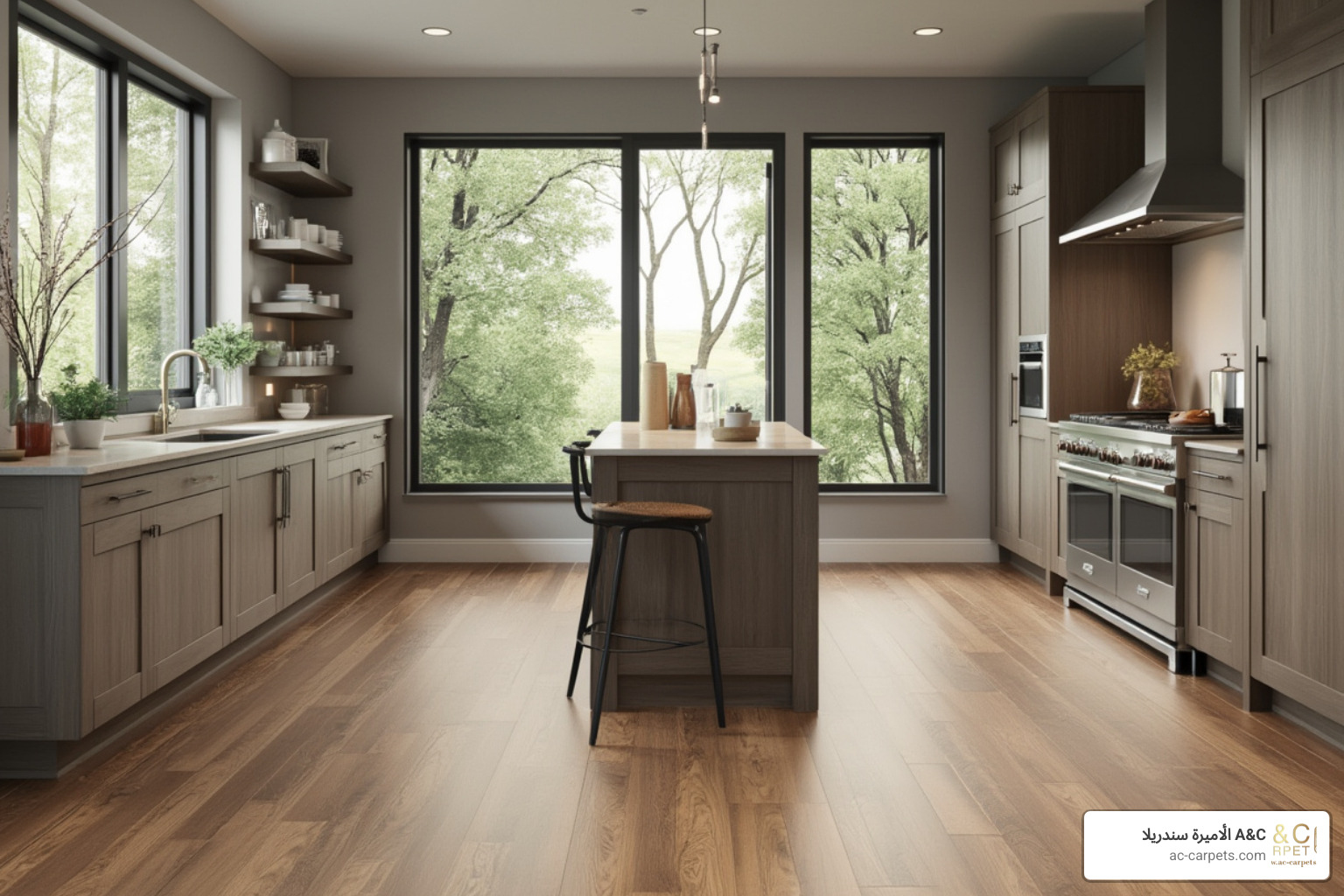
Sheet vinyl is your budget champion at just $1-$2 per square foot. It comes in big rolls, which means fewer seams and better water protection. The downside? Wrestling with a heavy roll can be tricky, making this a medium-difficulty DIY project. But for spaces like laundry rooms or basements where you want seamless water protection, it’s hard to beat.
Vinyl tiles cost a bit more at $1-$4 per square foot, but they’re incredibly DIY-friendly. Many come with peel-and-stick installation – literally just peel off the backing and stick them down. No special tools, no mess, no fuss. When installed properly, these can last up to 25 years. I’ve seen them transform tired bathrooms and kitchens beautifully.
Plank vinyl (LVP) is where vinyl really shines. At $2-$7 per square foot, it mimics hardwood so convincingly that guests often can’t tell the difference. The click-lock installation makes it perfect for weekend warriors – pieces just snap together like a puzzle. Plus, it’s genuinely waterproof and scratch-resistant, making it ideal for busy families with kids and pets.
The beauty of vinyl lies in its water-resistant properties and low maintenance. Spill your coffee? No problem. Kids track in mud? Easy cleanup. It’s practically designed for real life.
Laminate Flooring: The Look of Wood for Less
Want hardwood floors but your wallet says “not today”? Laminate flooring is your answer. At $3-$13 per square foot, it gives you that gorgeous wood look without the hardwood price tag.
Laminate is essentially a composite material with a clear protective layer on top and a photographic layer underneath that creates the wood or stone appearance. The technology has gotten so good that some laminate looks more consistent than real wood!
The click-lock installation system makes this a favorite for DIY enthusiasts. Pieces snap together over an underlayment, and you can often finish a room in a weekend. It’s also quite scratch resistant, perfect for homes with pets or heavy foot traffic.
Here’s the catch: laminate has moisture sensitivity. While it handles normal humidity fine, standing water can cause it to swell and buckle. This is why underlayment importance can’t be overstated – it provides crucial moisture protection and makes the floor feel more solid underfoot.
Tile Flooring: Durable and Timeless on a Dime
Don’t overlook tile when searching for the cheapest way to replace carpet. While the upfront cost might seem higher, tile’s incredible durability makes it a smart long-term investment.
Ceramic tile can cost as little as $0.50 per square foot for basic options, though expect to pay up to $7 for designer styles. It’s perfect for moisture-prone rooms like bathrooms and kitchens. When shopping for ceramic, always check the PEI rating scale – you want at least a rating of 3 for floor use. The Porcelain Enamel Institute sets these standards, and anything below 3 is really meant for walls only.
Porcelain tile starts around $3 per square foot but offers superior durability. It’s denser and less porous than ceramic, making it even more water-resistant and chip-resistant. For high-traffic areas, porcelain is worth the extra investment.
The best part about tile? It can literally last decades with proper care. I’ve seen 30-year-old tile floors that still look fantastic with just a good cleaning and fresh grout.
Creative & Ultra-Low-Cost Ideas
Sometimes the most creative solutions are also the cheapest. Let me share some unconventional ideas that might surprise you.
Carpet remnants are hidden treasures. These leftover pieces from larger installations often sell for pennies on the dollar. A carpet store might sell you a perfect 12′ x 5′ remnant for around $20. You can even turn these into custom rugs – check out this clever guide on how to Make a Rug With Carpet Remnants using just duct tape for finishing the edges.
Peel-and-stick carpet tiles at $1.50-$3.50 per square foot offer the ultimate in convenience. They’re perfect for basements, playrooms, or rental properties where you might need to replace individual sections later. Many are mold and mildew resistant, and installation couldn’t be easier.
Painted subfloor might sound crazy, but it can look amazing when done right. For under $1 per square foot, you can transform a clean plywood or concrete subfloor into something special. Sand, prime, paint with durable floor paint, and seal it properly. Some people even paint faux wood planks or tile patterns for a custom look that costs almost nothing.
Refinishing existing floors under that old carpet might be your biggest win. If you find hardwood, concrete, or even old tile, cleaning and refinishing these surfaces often costs less than installing anything new. Sometimes the cheapest way to replace carpet is simply revealing what was already there all along.
Slashing Costs: DIY Installation vs. Hiring a Pro
When we’re searching for the cheapest way to replace carpet, the biggest money-saver often comes down to one simple question: can we do this ourselves? The answer might surprise you – for many budget-friendly flooring options, DIY installation isn’t just possible, it’s actually designed to be homeowner-friendly.
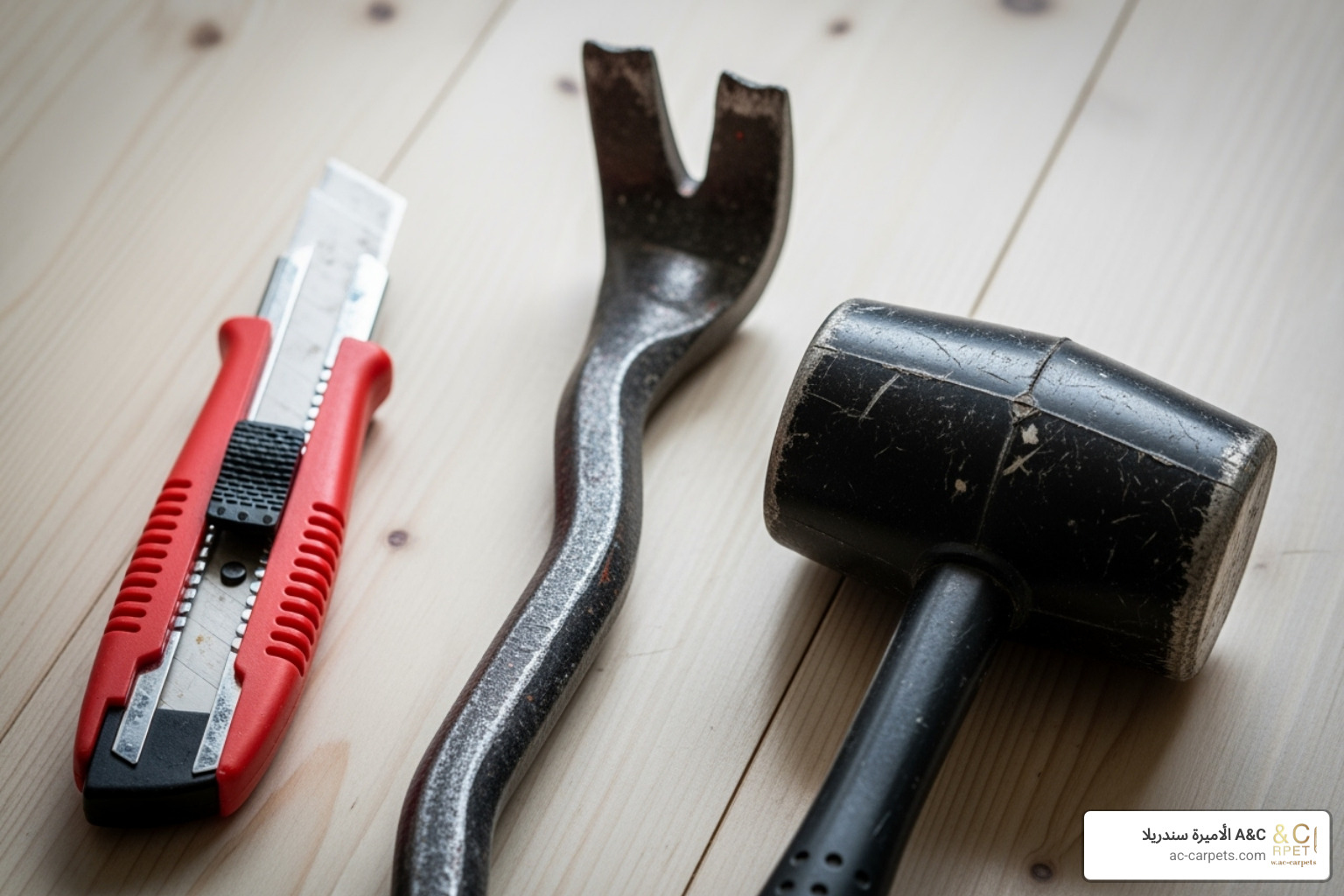
Professional installation typically adds $1 to $2 per square foot to your project cost, sometimes even more. For a modest 200-square-foot room, that’s an extra $200-$400 just in labor. When carpet replacement can average $1,777 professionally installed, doing it ourselves can cut that cost dramatically.
The beauty of modern flooring is that manufacturers have made installation increasingly DIY-friendly. They know homeowners want to save money, so they’ve designed products that work with our skill level, not against it.
DIY Installation: The Ultimate Cheapest Way to Replace Carpet?
Here’s where the magic happens. Many of today’s budget flooring options are practically begging us to install them ourselves.
Peel-and-stick options are the ultimate beginner’s dream. Whether we’re talking vinyl tiles or carpet tiles, the process is refreshingly straightforward: clean the subfloor, peel off the backing, and stick it down. The most challenging part? Making sure our measurements are accurate and our first row is perfectly straight.
Click-lock planks – found in both luxury vinyl planks and laminate flooring – are like adult-sized building blocks. Each piece simply snaps into the next with a satisfying click. We’ll need basic tools like a utility knife, measuring tape, and maybe a rubber mallet, but no specialized equipment.
The time commitment varies depending on the room size and our experience level. A weekend warrior can typically handle a small bedroom in a day, while a larger living area might take a weekend. The key is patience and attention to detail. Professional installers work faster because they’ve done it thousands of times, but we have something they don’t: unlimited time to get it right.
Tool rental keeps costs manageable. For most DIY flooring projects, we won’t need expensive equipment. Basic hand tools handle the majority of installations. If we do need something specialized, home improvement stores rent tools by the day or weekend, keeping our investment minimal.
The biggest challenge? Avoiding common installation mistakes that could cost us later. Rushing the process, skipping the underlayment, or ignoring manufacturer instructions can lead to buckling, gaps, or premature wear. But with YouTube tutorials and detailed installation guides, we have access to professional knowledge right at our fingertips.
Uncovering Hidden Costs: What the ‘Cheapest Way to Replace Carpet’ Might Not Include
Even when we’re doing the work ourselves, some costs have a sneaky way of creeping into our budget. Being aware of these upfront helps us plan realistically and still achieve the cheapest way to replace carpet.
Underlayment is often the forgotten hero of flooring projects. For laminate and some vinyl installations, this cushioning layer is essential – not optional. It provides moisture protection, sound dampening, and makes the floor feel more comfortable underfoot. Quality underlayment typically adds $0.50 to $1 per square foot to our material costs.
Subfloor preparation can be a budget surprise. That beautiful new flooring needs a smooth, level foundation to perform properly. If our subfloor has dips, cracks, or damage, we’ll need patching compounds or self-leveling solutions. Concrete floors require thorough cleaning and sometimes priming before installation.
Disposal fees for old carpet catch many homeowners off guard. That pile of old carpet and padding has to go somewhere, and most regular trash pickup won’t handle it. Disposal fees vary by location but budget $50-$150 for professional removal or dumpster rental.
Adhesives and sealants add up quickly. While peel-and-stick products include adhesive, other installations might need additional glues, transition strips, or edge sealants. For laminate flooring, sealing the edges against moisture is crucial, especially in homes with pets or high humidity.
Baseboard replacement or touch-up often becomes necessary. Removing carpet usually means removing baseboards to access tack strips properly. If they get damaged during removal – and they often do – we’ll need replacement materials and paint for touch-ups.
Basic tools represent a small but real investment. We’ll need items like a sharp utility knife, measuring tape, knee pads, and possibly a pry bar. While we don’t need a contractor’s full toolkit, having the right tools makes the job much easier and helps achieve professional-looking results.
The good news? Many of these costs are one-time investments. Quality tools serve us for future projects, and learning these skills builds confidence for other home improvements. By factoring in these hidden costs upfront, we can still achieve significant savings while getting beautiful, durable flooring that transforms our space.
Frequently Asked Questions about Budget Carpet Replacement
When you’re exploring the cheapest way to replace carpet, questions naturally pop up. We’ve helped countless homeowners steer these decisions, so let’s tackle the most common concerns that come up during budget flooring projects.
How long does the cheapest flooring last?
Here’s the honest truth about budget flooring: you often get what you pay for, but that doesn’t mean cheap equals worthless. Understanding lifespan helps you make smarter long-term decisions.
Cheap carpet – the absolute bottom-tier stuff you’ll find for $1-$3 per square foot – typically lasts just one to five years. That’s a far cry from quality carpets that can last 15 to 25 years. When you do the math, replacing cheap carpet every few years often costs more than investing in better alternatives upfront.
Vinyl flooring tells a completely different story. With proper care and installation, vinyl tiles can last up to 25 years – that’s five times longer than cheap carpet! Sheet vinyl and luxury vinyl planks also deliver impressive durability, often lasting 10 years or more. This longevity makes vinyl one of the smartest long-term investments when you’re looking for the cheapest way to replace carpet.
Laminate flooring typically gives you around 10 years of service, though its lifespan heavily depends on moisture protection and how well you handle heavy impacts. Keep water away from the seams, and laminate can serve you well.
Ceramic and porcelain tiles are the marathon runners of flooring. These durable champions can last for decades with minimal wear, easily outlasting any carpet option. Even basic ceramic tiles often outlive multiple carpet replacements.
Painted subfloors offer a shorter-term solution, lasting anywhere from a few years to a decade depending on paint quality, sealant, and foot traffic. They’re perfect for temporary situations or creative spaces where you want flexibility.
The secret ingredient for any flooring longevity? Proper maintenance. Regular cleaning and prompt attention to spills or damage can significantly extend the life of even budget-friendly options.
What is the best budget flooring for high-traffic or wet areas?
Some areas of your home work harder than others. High-traffic hallways, moisture-prone bathrooms, and busy kitchens demand flooring that can handle the challenge without breaking your budget.
For wet areas like bathrooms, kitchens, and laundry rooms, water resistance is non-negotiable. Vinyl flooring – whether sheet, tile, or plank – tops our recommendation list. Made primarily with polyvinyl chloride (PVC), vinyl naturally resists water, and many luxury vinyl planks are completely waterproof. Sheet vinyl, with its minimal seams, provides excellent protection against spills and splashes.
Porcelain tile deserves special mention for wet areas. Its dense composition makes it virtually impervious to water, creating an outstanding choice for shower areas and kitchen floors. Ceramic tile works well too, just ensure it has a PEI rating of 3 or higher for floor applications.
High-traffic areas like entryways, hallways, and living rooms need flooring that can handle constant foot traffic without showing wear. Vinyl planks or tiles excel here, offering durability, scratch resistance, and easy cleaning. Their ability to bounce back from daily wear makes them ideal for busy households.
Quality laminate flooring can handle high-traffic living areas beautifully, especially versions with strong wear layers. Just remember to keep moisture at bay – laminate’s weakness is water infiltration at the seams.
For spaces that need carpet’s comfort but face heavy use, heavy-duty peel-and-stick carpet tiles offer a practical solution. Look for 36-ounce tiles rather than lightweight 14-ounce options. Individual tiles can be replaced easily when they show wear, making maintenance simple and cost-effective.
The key is matching your flooring’s strengths to your room’s specific challenges. Investing slightly more in durable, water-resistant materials for demanding areas saves significant money and frustration over time.
Can I install new flooring directly over my old carpet?
This question comes up frequently when homeowners seek the cheapest way to replace carpet while avoiding removal work. The straightforward answer is no – you generally cannot install new flooring directly over old carpet.
Old carpet creates problems that new flooring can’t overcome. The soft, uneven surface makes it impossible for rigid materials like laminate, luxury vinyl planks, or tile to lay properly. You’ll end up with buckling, gaps, and cracks that ruin both the appearance and durability of your new floor.
Moisture becomes trapped beneath new flooring when old carpet remains. This creates perfect conditions for mold, mildew, and unpleasant odors that can damage your new investment and create unhealthy living conditions.
Subfloor integrity requires direct access for proper assessment. Old carpet hides potential problems like water damage, rot, or structural issues that must be addressed before installing new flooring. Skipping this inspection step often leads to costly surprises later.
Proper adhesion and stability demand direct contact between new flooring and the subfloor. Most flooring materials rely on this connection for their installation systems to work correctly.
The rare exception involves installing peel-and-stick carpet tiles over existing carpet, but only under very specific conditions. The existing carpet must be extremely low-pile, completely flat, thoroughly clean, and well-secured without any loose areas or ripples. Even then, this works only as a semi-permanent solution.
For any other flooring type – vinyl planks, laminate, tile, or hardwood – removing old carpet and properly preparing the subfloor is absolutely essential. Taking shortcuts here typically leads to installation failures that cost far more to fix than doing the job right the first time.
The proper removal process might seem like extra work, but it’s actually part of achieving the true cheapest way to replace carpet – doing it once, doing it right, and enjoying years of trouble-free flooring.
Conclusion: A Fresh Floor Without the Financial Fuss
You’ve made it through the journey of finding the cheapest way to replace carpet, and what a journey it’s been! From pulling back that first corner of old carpet to exploring waterproof vinyl tiles and creative painted subfloors, we’ve covered a world of possibilities that prove beautiful flooring doesn’t have to drain your savings account.
The secret we’ve learned together is simple: planning and preparation are your best friends. When you take time to inspect what’s hiding under that old carpet, choose materials that match your lifestyle, and honestly assess your DIY skills, you’re setting yourself up for success. Whether you find hidden hardwood treasures or decide that peel-and-stick vinyl tiles are perfect for your busy kitchen, the right choice is the one that fits your specific needs and budget.
The cheapest way to replace carpet isn’t always about finding the lowest price tag. It’s about finding the best value – that sweet spot where affordability meets durability. A vinyl floor that lasts 25 years at $3 per square foot beats cheap carpet that needs replacing every few years. Your wallet will thank you in the long run.
Modern flooring solutions have come incredibly far. Today’s vinyl planks look amazingly like real hardwood, ceramic tiles offer endless design possibilities, and even painted subfloors can become stunning focal points with a little creativity. The options that seemed “budget” or “temporary” just a few years ago now deliver professional-looking results that rival much more expensive alternatives.
At الأميرة سندريلا A&C, we understand that every home deserves flooring that combines elegance with practicality. Our innovative carpet alternatives and modern flooring solutions are designed with real families in mind – people who want beautiful spaces without the hefty price tags. We’ve seen countless homeowners transform their spaces with smart, budget-conscious choices that deliver lasting beauty and functionality.
Don’t let cost concerns keep you from creating the home you love. With the knowledge you now have about subfloor preparation, material selection, and installation options, you’re ready to tackle your flooring project with confidence. Take your time, do your research, and remember that even small improvements can make a huge difference in how your space looks and feels.
Ready to explore more neat and practical solutions? Check out بديل السجاد الأناقة والعملية مع مصنع ا for more neat and practical flooring solutions that prove you can have both style and savings. Your dream floors are closer than you think!
